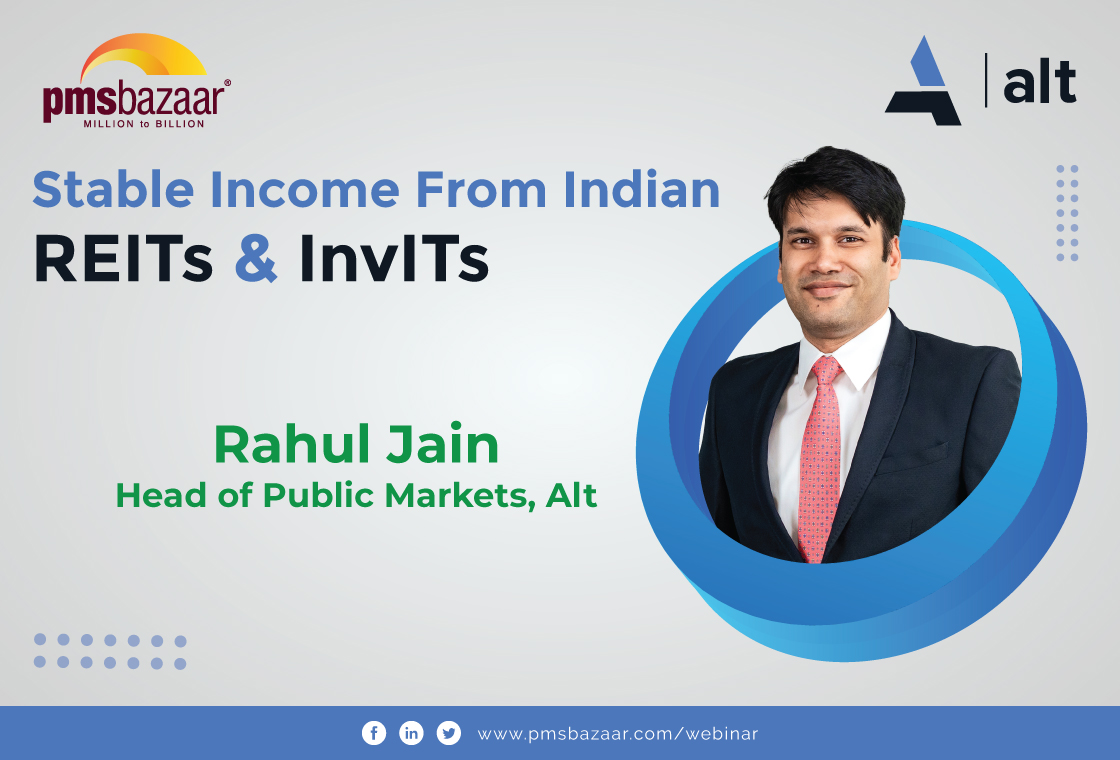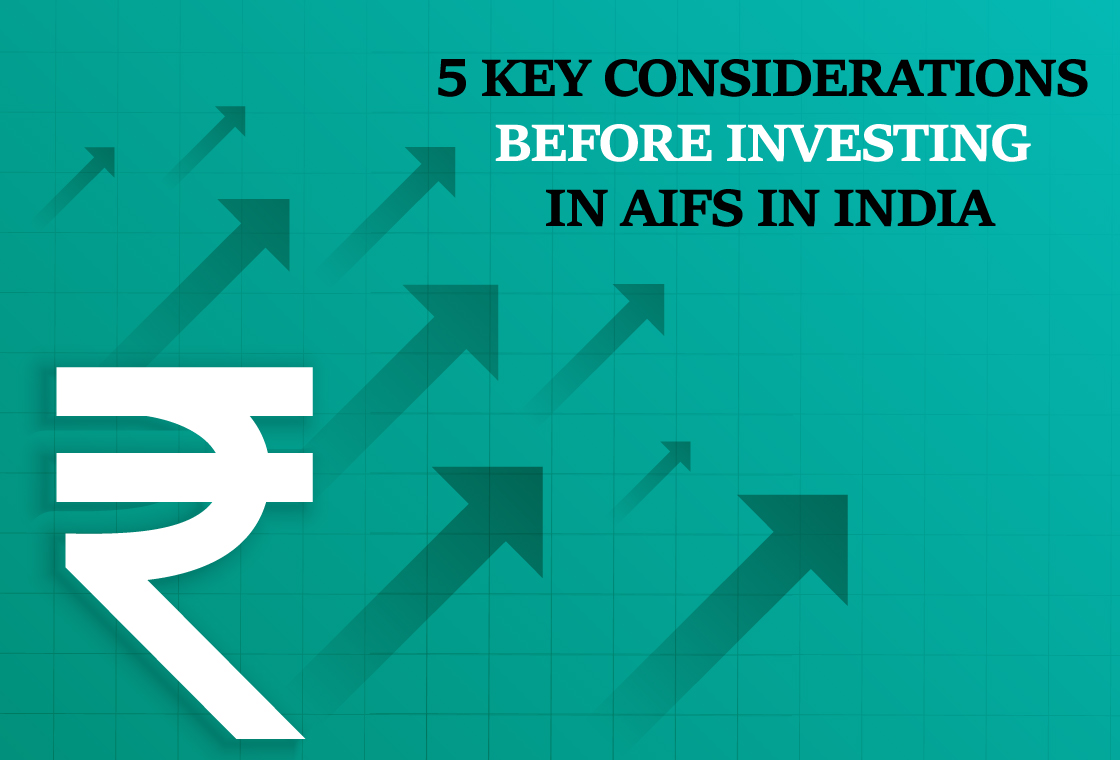PMS Bazaar recently organized a webinar titled “Stable Income from Indian REITs and InvITs,” which featured Mr. Rahul Jain, Head of Public Markets, Alt.

The webinar blog covers insights from Mr. Jain, which includes his firm’s new PMS product centred on listed REITs and InvITs. It covered the product’s objectives, target returns, tax efficiency, diversification benefits, liquidity, and suitability for various investor profiles. It also highlighted how the PMS adds value through expert research, timing, and active portfolio management.
Key aspects covered in this webinar blog are
- Target returns and product advantages
- Highlighting key asset class characteristics
- Tax efficiency and diversification
- Understanding price appreciation and re-rating triggers
- Core portfolio component vs. satellite exposure
- Taxation for domestic and NRI investors
- The PMS value-add over direct investment
- Safety, suitability, and portfolio allocation
Summary: Mr. Rahul Jain introduced a new PMS product focused on listed REITs and InvITs, targeting 8–8.5% yield and 13–15% IRR over four to five years. He highlighted benefits like liquidity, tax efficiency, low volatility, and diversification. The PMS offers expert timing, active allocation, and research-backed alpha generation. Suitable for conservative and income-seeking investors, REITs and InvITs provide steady returns, SEBI-governed safety, and long-term portfolio stability with an ideal 10–25% allocation at a minimum three-year horizon.
Exploring Opportunities in Listed REITs and InvITs: Insights from Mr. Rahul Jain
Mr. Rahul Jain started the session by announcing that his firm had launched a new Portfolio Management Service (PMS) product at the beginning of the month. The product's primary focus, he stated, was on listed REITs and InvITs. He then outlined the key reasons for this focus.
He explained that listed REITs and InvITs offer investors a pathway to achieve a stable income by investing in institutional-grade infrastructure and real estate assets. Furthermore, he highlighted the benefit of tax-efficient returns on a regular basis, coupled with the potential for capital appreciation over time.
Target Returns and Product Advantages
In terms of financial goals, Mr. Jain shared that the product was targeting a yield of approximately 8% to 8.5% and a Target Internal Rate of Return (IRR) of about 13% to 15% over a four to five-year period. This structure, he noted, was designed to provide investors with a blend of both regular income and capital appreciation.
He further elaborated on the product's advantages:
- Current Income: Both InvITs and REITs provide quarterly distributions, with a blended yield projected to be 8% to 9%.
- Institutional Asset Access: Investors gain access to high-quality, Grade A assets. For InvITs, this includes infrastructure assets like power grids and, in some cases, renewable assets. For REITs, examples include commercial properties like Manayata Tech Park, owned by Embassy REIT, and other business parks under Mindspace REIT and Knowledge Realty Trust.
- Regulation and Governance: He assured the audience that both the REITs and InvITs, as well as the PMS itself, are governed by SEBI's regulations, offering a layer of investor protection.
Highlighting Key Asset Class Characteristics
Mr. Jain stressed that one of the most compelling features of REITs and InvITs is the liquidity they offer. He pointed out that direct investment in infrastructure or real estate typically requires a very large ticket size and a lengthy exit process, sometimes taking years. In contrast, through listed REITs and InvITs, an investor can sell their holding on the exchange, benefiting from a T+1 settlement—an exceptionally high degree of liquidity for an otherwise illiquid asset class.
He also discussed why institutional investors favour this space:
- Lower Volatility: Due to strong underlying cash flows, these assets typically exhibit lower volatility compared to pure equity.
- Low Correlation: Analysis over the last 25 quarters showed that the REIT and InvIT index had a low correlation (less than 25%) with equity markets and its volatility was one-third lower than equity volatility.
Mr. Jain presented an analysis showing that since mid-2019, the Nifty REIT and InvIT Index's total returns were closely aligned with the Nifty 50 (13% versus 13.7%), but with the added benefit of a much higher yield (over 8%) compared to traditional debt instruments like Fixed Deposits (FDs), G-Secs, or debt mutual funds. He concluded that the product offers a hybrid advantage, combining the high yield of a debt product with the capital appreciation potential similar to equity.
Tax Efficiency and Diversification
The tax efficiency of the distributions, coupled with liquidity, was presented as a factor that makes the asset class stand out. He cited an analysis for the last financial year which showed that approximately 60% of the income distributed was tax-free. He illustrated that for an investor in the 30% tax bracket, the post-tax return came to about 7%, which is a significant advantage compared to the sub-5% post-tax return of a typical 7% FD.
Finally, Mr. Jain underscored the role of this product as an essential diversification tool for any investor's portfolio. He reaffirmed the asset class's low beta (0.25) and low volatility, concluding that allocating a portion of a portfolio to REITs and InvITs helps in improving risk-adjusted returns.
Understanding Price Appreciation and Re-rating Triggers
Mr. Jain was asked that while listed REITs in India have provided steady yields, their price appreciation has appeared limited. They asked Mr. Jain for his view on potential triggers for a re-rating of the asset class.
Mr. Jain immediately challenged the premise of limited appreciation. He stated that the first REIT, Embassy REIT, had an IPO price of ₹300 and now trades around ₹430–440, representing a 45% return over six years. This appreciation translates to approximately 6% capital appreciation annually on top of the 8% yield, resulting in a total return in the 13–15% range, which he considered quite good.
He emphasized that timing is crucial, advising that investors must be "cognizant of the fact that they need to invest at the right time," which is what a service provider like his firm offer.
He then identified several factors that could drive the next phase of re-rating:
- REIT Reclassification: The recent reclassification of REITs from a hybrid structure to equity has already supported higher valuations.
- Interest Rate Moderation: Structurally declining interest rates help drive down cap rates, which in turn supports higher valuations for the assets.
- Higher Occupancy and Leasing: He pointed out that leasing activity has been robust, with recent quarters showing a significant surge in occupancy.
- New Asset Additions: He expressed optimism, noting that more new REITs and private InvITs are expected to list over the next 12 to 18 months, which will deepen the market.
Core Portfolio Component vs. Satellite Exposure
The host then highlighted the low volatility and low correlation of REITs and InvITs, asking if they should be considered as core portfolio component for long-term investors, rather than just an alternative or satellite exposure.
Mr. Jain suggested that the role of these products depends on the investor's profile:
- For Retirees/Passive Income Seekers: They can easily allocate 10% to 20% of their portfolio. This provides a higher post-tax return compared to debt, and the capital appreciation acts as an inflation hedge, as their investment appreciates annually.
- For Wealth Accumulators (e.g., 35–40-year-olds): Since they may not need the current income, they can simply redeploy the yield back into the portfolio, accelerating their growth.
He concluded that for investors looking to smoothen their return profile (a primary function of debt exposure), a portion of that debt exposure can be shifted to REITs and InvITs to deliver a slightly higher post-tax return without losing the desired portfolio characteristic.
Taxation for Domestic and NRI Investors
Addressing the critical topic of tax efficiency, Mr. Jain explained that investing through their PMS product does not change the core tax treatment for the investor, as the holdings are directly in the client's Demat account. The taxation is a direct pass-through.
He detailed the three main components of distributions:
- Dividend: Generally tax-free for investors. (only in certain cases it’s taxable)
- Interest Income: Taxable in the investor’s hands as per their tax bracket.
- Repayment of Capital (RoC): Tax-free in the hands of the investor, but it reduces the cost of acquisition when the units are eventually sold. This makes the tax liability "back-ended" and subject to the generally lower capital gains tax rate, which can be much more tax-efficient than debt products.
The PMS Value-Add over Direct Investment
A common investor question was posed: with a limited number of listed instruments, what additional value-add does the PMS provide over direct market purchase?
Mr. Jain reiterated that the most important factor is investing at the right time. He stressed that there is little to no institutional coverage for most InvITs, and while there is some for REITs, the level of research is often insufficient.
His firm's value proposition is providing the expertise to:
- Deep-Dive Analysis: Conduct thorough research on the underlying portfolio and individual assets, including predicting yield growth over the next 12–24 months.
- Active Allocation: Decide between different REITs/InvITs and even determine whether it's better to hold cash at certain times.
- Delivering Alpha: This active, research-backed strategy aims to deliver an alpha return above the asset class's historical average of 13%.
Safety, Suitability, and Portfolio Allocation
The discussion wrapped up with audience questions regarding suitability and portfolio construction:
- Safety: REITs and InvITs are governed by SEBI regulations, offering a layer of protection.
- Suitable Investors: They are best suited for debt-oriented or conservative investors who want a few extra percentage points of return compared to traditional debt, as well as for those looking to smooth out equity portfolio volatility (e.g., investors in balanced funds).
- Ideal Exposure: Depending on the investor type, the allocation can range from 10% to 25% of the overall portfolio.
- Time Horizon: An investor should look at a minimum three-year time horizon for the full cycle to play out and to realize the best results.
Mr. Jain also cautioned direct investors on InvITs, noting that without regular acquisition of new assets, the underlying projects have a finite concession period, and the terminal value can eventually go to zero. He stressed that understanding the IRR of each project is crucial for investment decisions.
Mr. Rahul Jain covered all the topics mentioned above in-depth and answered questions from the audience towards the end of the session. For more such insights on this webinar, watch the recording of this insightful session through the appended link below.
Get access to rich data and analytics of PMS & AIF by subscribing to us. Join the 75000+ investors & experts: Subscribe NOW
Recent Blogs
.jpg)
Passively Active Investing — A Modern Investor’s Lens on ETF-Based PMS
PMS Bazaar recently organized a webinar titled “Passively Active Investing — A Modern Investor’s Lens on ETF-Based PMS,” which featured Mr. Karan Bhatia, Co-Founder and Co-Fund Manager , Pricebridge Honeycomb ETF PMs. This blog covers the important points shared in this insightful webinar.

Spot the Trouble: Red Flags in Equity Investment Analysis
PMS Bazaar recently organized a webinar titled “Spot the Trouble: Red Flags in Equity Investment Analysis,” which featured Mr. Arpit Shah, Co-Founder & Director, Care Portfolio Managers. This blog covers the important points shared in this insightful webinar.

Long-Only AIFs Rebound Sharply in October; Long-Short Strategies Lag Despite Lower Volatility
106 long-only AIFs averaged 3.68% vs 32 long-short AIFs at 2.7%; only 24–31% of funds beat key indices

Markets log strongest monthly gains in 7 months; PMS performance turns near-uniform in October
Nifty 50 TRI gained 4.62%, BSE 500 TRI rose 4.27%; 415 of 427 equity PMSes ended positive

How SMEs are Shaping India’s Investment Landscape?
PMS Bazaar recently organized a webinar titled “How SMEs are Shaping India’s Investment Landscape?” which featured Mr. Shrikant Goyal, Fund Manager, GetFive Opportunity Fund.

5 Key Considerations Before Investing in AIFs in India
Alternative Investment Funds (AIFs) have emerged as a compelling option for sophisticated investors seeking diversification and potentially superior returns. But venturing into AIFs requires a clear understanding of their unique characteristics that go beyond simply knowing what they are and their categories.

How AIF can help in diversification?
Traditionally, Indian investors have relied on a mix of stocks and bonds to build their wealth. While this approach offers diversification, it can still leave your portfolio vulnerable to market fluctuations. Enter Alternative Investment Funds (AIFs), a dynamic asset class gaining traction for its ability to unlock diversification beyond the realm of conventional options.

Long-Short AIFs Outperform Again Even as Markets Rebound in September
104 long-only funds shows an average monthly gain of just 0.37 per cent, while long-short AIF category averaged 0.94 per cent

